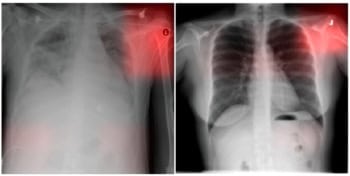
Physicists in the US have shown that protons themselves can be used to provide the complex 3D images essential for tailoring proton therapy to individual patients. Researchers in the US built a prototype detector to carry out “proton computed tomography” (proton CT), and found that in around 6 min it could generate maps of proton stopping power – energy lost per unit distance in a material – that were more accurate and required a much lower radiation dose than existing techniques.
Proton therapy is becoming an increasingly popular tool to treat cancer because it can be used to target tumours very precisely. Unlike most other types of radiation, protons deposit a large fraction of their energy at the point where they stop in the body. By tuning the beam so that protons stop where the tumour is located, therapy can be made more effective and safer.
To deliver the radiation to a particular point in a person’s body, medical physicists must first establish the extent to which protons will be slowed down by intermediate layers of tissue. This is currently done by placing the patient in an X-ray CT scanner and creating a 3D plot of X-ray absorption within the relevant part of their body. But the accuracy of this technique is limited by a mismatch between X-ray absorption and proton energy loss within particular types of tissue.
Direct measurement
Proton CT would overcome this problem by measuring proton energy loss directly. Working scanners would employ the same source of protons used to carry out the therapy, but would require a different set-up – a higher-energy but lower-intensity beam and detectors that could be moved relative to the patient to get a 360° view. And as with X-ray CT, the procedure would be carried out ahead of treatment.
The idea of proton CT has been around ever since computer tomography was first proposed in the early 1960s. But the need for a proton beam makes it more expensive than X-ray CT and it also requires a more complex detector as well as more intense computation to transform measurements into an image, according to Robert Johnson, a particle physicist at the University of California, Santa Cruz.
In the latest work, Johnson and colleagues at Santa Cruz, Loma Linda University, Northern Illinois University, University of Wollongong and Baylor University set out to build a prototype proton CT scanner that was large enough to image a fake (phantom) human head and quick enough to be usable clinically. The system uses a couple of spare silicon detectors from NASA’s Fermi Gamma-ray Space Telescope, which Johnson had previously worked on. The idea was to place these detectors in the path of a proton beam, with one positioned in front of the head in question and the other behind, to plot the trajectory of the protons through the head.
Specific trajectories
By subtracting the known energy of the particle beam from the energy dumped in a series of plastic scintillators placed behind the second silicon detector, the researchers could work out how much energy a head absorbs along specific trajectories. By then rotating the head very slightly and repeating the process, they could build up a detailed 3D image of the head’s proton stopping power.
The team tested its device in the proton beam at the Northwestern Medicine Chicago Proton Center using phantom heads made from various materials with different stopping powers. Recording the trajectory and energy of more than a million protons a second using very fast electronics, within about six minutes they were able to generate an image with stopping powers generally within 1% of their known values.
Johnson says he does not have precise figures for the accuracy of proton stopping powers obtained using X-ray CT. But he thinks that proton CT is probably better suited to certain kinds of tissue. “If the tissues are all soft and fairly uniform, then X-ray CT will likely be just as accurate as proton CT,” he says. “If there are layers of dense material, then I think we can do better, but that is what we are currently trying to prove.”
Lower doses
The researchers also found they could significantly reduce the dose needed to do the scanning. Whereas a typical X-ray scan of the head requires between 30–50 mGy, they needed just 1.4 mGy using protons.
Johnson and collaborators are now applying for grants to develop a more compact detector with even faster electronics, to reduce the necessary exposure time to about a minute. Six minutes, he reckons, “isn’t bad”, but is not ideal. Having been in an MRI scanner for longer than six minutes, he says the duration “is doable but not the most pleasant thing”.
The American group is one of several around the world that are developing proton CT, with others located in Italy, Japan and the UK. Leader of the British group, Nigel Allinson of the University of Lincoln, says that Johnson and colleagues “certainly set a standard for others to follow”, but notes that technical success will need to be followed by clinical trials as well as assessments of cost and the extent to which the technique “fits with radiotherapy workflows”.
“Still a long way”
Likewise, Mohammad Naimuddin of the University of Delhi cautions that “there is still a long way” before proton CT can be used clinically. Naimuddin, who has collaborated with some members of Johnson’s group, says that the latest work represents a “significant improvement compared to past efforts”, but argues that better modelling of proton scattering off tissue is needed to improve the technique’s resolution. “In the current paper the spatial resolution of the phantom image is still not comparable to X-ray CT,” he says.
The research is reported on the arXiv server.



